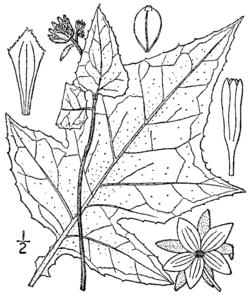| Polymnia | |
|---|---|
 | |
| Pale-flowered leafcup (Polymnia canadensis) [1] | |
| Scientific classification | |
| Kingdom: | Plantae |
| Clade: | Tracheophytes |
| Clade: | Angiosperms |
| Clade: | Eudicots |
| Clade: | Asterids |
| Order: | Asterales |
| Family: | Asteraceae |
| Subfamily: | Asteroideae |
| Tribe: | Polymnieae (H.Rob.) Panero |
| Genus: | Polymnia Kalm |
| Type species | |
| Polymnia canadensis | |
| Synonyms [2] | |
| |
Polymnia is a genus of American plants in the sunflower family. [3] [4] [5] It is the only genus in the tribe Polymnieae. [6] Several species are known by the common name leafcup. [7]
- Species [2] [8] [9]
- Polymnia aspera (Mart.) Mart. ex DC. - Mexico
- Polymnia canadensis L. - Ontario, much of eastern + central United States
- Polymnia cocuyensis Cuatrec. - Boyacá in Colombia
- Polymnia cossatotensis Pittman & V.M.Bates - Arkansas
- Polymnia johnbeckii D.Estes - Tennessee
- Polymnia laevigata Beadle - MO KY TN AL GA FL
- Polymnia quichensis J.M.Coult. - Costa Rica, Guatemala
- Polymnia sonchifolia Poepp. - Bolivia
- Formerly included [2]
Numerous species now in other genera: Axiniphyllum Berlandiera Didelta Guizotia Melampodium Montanoa Rumfordia Smallanthus Sphagneticola Unxia